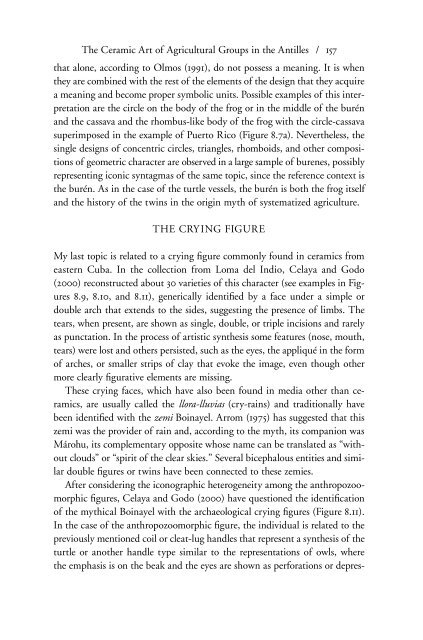Dialogues in Cuban Archaeology
by L. Antonio Curet, Shannon Lee Dawdy, and Gabino La Rosa Corzo
by L. Antonio Curet, Shannon Lee Dawdy, and Gabino La Rosa Corzo
Create successful ePaper yourself
Turn your PDF publications into a flip-book with our unique Google optimized e-Paper software.
The Ceramic Art of Agricultural Groups <strong>in</strong> the Antilles / 157<br />
that alone, accord<strong>in</strong>g to Olmos (1991), do not possess a mean<strong>in</strong>g. It is when<br />
they are comb<strong>in</strong>ed with the rest of the elements of the design that they acquire<br />
a mean<strong>in</strong>g and become proper symbolic units. Possible examples of this <strong>in</strong>terpretation<br />
are the circle on the body of the frog or <strong>in</strong> the middle of the burén<br />
and the cassava and the rhombus-like body of the frog with the circle-cassava<br />
superimposed <strong>in</strong> the example of Puerto Rico (Figure 8.7a). Nevertheless, the<br />
s<strong>in</strong>gle designs of concentric circles, triangles, rhomboids, and other compositions<br />
of geometric character are observed <strong>in</strong> a large sample of burenes, possibly<br />
represent<strong>in</strong>g iconic syntagmas of the same topic, s<strong>in</strong>ce the reference context is<br />
the burén. As <strong>in</strong> the case of the turtle vessels, the burén is both the frog itself<br />
and the history of the tw<strong>in</strong>s <strong>in</strong> the orig<strong>in</strong> myth of systematized agriculture.<br />
THE CRYING FIGURE<br />
My last topic is related to a cry<strong>in</strong>g ¤gure commonly found <strong>in</strong> ceramics from<br />
eastern Cuba. In the collection from Loma del Indio, Celaya and Godo<br />
(2000) reconstructed about 30 varieties of this character (see examples <strong>in</strong> Figures<br />
8.9, 8.10, and 8.11), generically identi¤ed by a face under a simple or<br />
double arch that extends to the sides, suggest<strong>in</strong>g the presence of limbs. The<br />
tears, when present, are shown as s<strong>in</strong>gle, double, or triple <strong>in</strong>cisions and rarely<br />
as punctation. In the process of artistic synthesis some features (nose, mouth,<br />
tears) were lost and others persisted, such as the eyes, the appliqué <strong>in</strong> the form<br />
of arches, or smaller strips of clay that evoke the image, even though other<br />
more clearly ¤gurative elements are miss<strong>in</strong>g.<br />
These cry<strong>in</strong>g faces, which have also been found <strong>in</strong> media other than ceramics,<br />
are usually called the llora-lluvias (cry-ra<strong>in</strong>s) and traditionally have<br />
been identi¤ed with the zemi Bo<strong>in</strong>ayel. Arrom (1975) has suggested that this<br />
zemi was the provider of ra<strong>in</strong> and, accord<strong>in</strong>g to the myth, its companion was<br />
Márohu, its complementary opposite whose name can be translated as “without<br />
clouds” or “spirit of the clear skies.” Several bicephalous entities and similar<br />
double ¤gures or tw<strong>in</strong>s have been connected to these zemies.<br />
After consider<strong>in</strong>g the iconographic heterogeneity among the anthropozoomorphic<br />
¤gures, Celaya and Godo (2000) have questioned the identi¤cation<br />
of the mythical Bo<strong>in</strong>ayel with the archaeological cry<strong>in</strong>g ¤gures (Figure 8.11).<br />
In the case of the anthropozoomorphic ¤gure, the <strong>in</strong>dividual is related to the<br />
previously mentioned coil or cleat-lug handles that represent a synthesis of the<br />
turtle or another handle type similar to the representations of owls, where<br />
the emphasis is on the beak and the eyes are shown as perforations or depres-


















